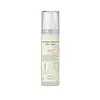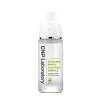What's inside
What's inside
 Key Ingredients
Key Ingredients

 Benefits
Benefits

 Concerns
Concerns

No concerns
 Ingredients Side-by-side
Ingredients Side-by-side

Water
Skin ConditioningButylene Glycol
HumectantNiacinamide
SmoothingEthylhexyl Stearate
EmollientCaprylic/Capric Triglyceride
MaskingCetyl Ethylhexanoate
EmollientGlutathione
Sodium Ascorbyl Phosphate
AntioxidantSalix Alba Bark Extract
AstringentAdenosine
Skin ConditioningSodium Hyaluronate
HumectantHydroxypropyltrimonium Hyaluronate
Sodium Acetylated Hyaluronate
HumectantHydrolyzed Hyaluronic Acid
HumectantHyaluronic Acid
HumectantSodium Hyaluronate Crosspolymer
HumectantHydrolyzed Sodium Hyaluronate
Skin ConditioningPotassium Hyaluronate
Skin ConditioningPanthenol
Skin ConditioningSqualane
EmollientGlycerin
HumectantAllantoin
Skin ConditioningCyanocobalamin
Skin ConditioningTerminalia Ferdinandiana Fruit Extract
AntioxidantHippophae Rhamnoides Fruit Extract
Skin ConditioningMalpighia Glabra Fruit Extract
Skin ConditioningBrassica Oleracea Italica Extract
AstringentMorus Alba Root Extract
BleachingPhaseolus Radiatus Seed Extract
Skin ConditioningCanavalia Gladiata Seed Extract
Skin ConditioningGlycine Soja Seed Extract
Skin ConditioningLens Esculenta Seed Extract
Skin ProtectingCeratonia Siliqua Seed Extract
Skin ConditioningCentella Asiatica Leaf Extract
Skin ConditioningCeramide NP
Skin ConditioningAcetyl Octapeptide-3
HumectantDipeptide-1
Skin ConditioningTripeptide-2
Skin ConditioningPalmitoyl Dipeptide-7
Skin ConditioningDipeptide-4
Skin ConditioningSorbitan Stearate
EmulsifyingCetearyl Alcohol
Emollient1,2-Hexanediol
Skin ConditioningStearic Acid
CleansingPolysorbate 60
EmulsifyingEthylhexylglycerin
Skin ConditioningHydrogenated Olive Oil Unsaponifiables
EmollientDisodium EDTA
Hydroxypropyl Cyclodextrin
MaskingPueraria Lobata Root Extract
HumectantLactobacillus Ferment Lysate
Skin ConditioningChlorphenesin
AntimicrobialMaltodextrin
AbsorbentMelia Azadirachta Flower Extract
Skin ConditioningOcimum Sanctum Leaf Extract
Skin ConditioningMelia Azadirachta Leaf Extract
Skin ConditioningArginine
MaskingPhytosterols
Skin ConditioningCarbomer
Emulsion StabilisingCurcuma Longa Root Extract
MaskingCorallina Officinalis Extract
Skin ConditioningCaprylyl Glycol
EmollientSodium Citrate
BufferingPolyglyceryl-10 Laurate
Skin ConditioningCitric Acid
BufferingWater, Butylene Glycol, Niacinamide, Ethylhexyl Stearate, Caprylic/Capric Triglyceride, Cetyl Ethylhexanoate, Glutathione, Sodium Ascorbyl Phosphate, Salix Alba Bark Extract, Adenosine, Sodium Hyaluronate, Hydroxypropyltrimonium Hyaluronate, Sodium Acetylated Hyaluronate, Hydrolyzed Hyaluronic Acid, Hyaluronic Acid, Sodium Hyaluronate Crosspolymer, Hydrolyzed Sodium Hyaluronate, Potassium Hyaluronate, Panthenol, Squalane, Glycerin, Allantoin, Cyanocobalamin, Terminalia Ferdinandiana Fruit Extract, Hippophae Rhamnoides Fruit Extract, Malpighia Glabra Fruit Extract, Brassica Oleracea Italica Extract, Morus Alba Root Extract, Phaseolus Radiatus Seed Extract, Canavalia Gladiata Seed Extract, Glycine Soja Seed Extract, Lens Esculenta Seed Extract, Ceratonia Siliqua Seed Extract, Centella Asiatica Leaf Extract, Ceramide NP, Acetyl Octapeptide-3, Dipeptide-1, Tripeptide-2, Palmitoyl Dipeptide-7, Dipeptide-4, Sorbitan Stearate, Cetearyl Alcohol, 1,2-Hexanediol, Stearic Acid, Polysorbate 60, Ethylhexylglycerin, Hydrogenated Olive Oil Unsaponifiables, Disodium EDTA, Hydroxypropyl Cyclodextrin, Pueraria Lobata Root Extract, Lactobacillus Ferment Lysate, Chlorphenesin, Maltodextrin, Melia Azadirachta Flower Extract, Ocimum Sanctum Leaf Extract, Melia Azadirachta Leaf Extract, Arginine, Phytosterols, Carbomer, Curcuma Longa Root Extract, Corallina Officinalis Extract, Caprylyl Glycol, Sodium Citrate, Polyglyceryl-10 Laurate, Citric Acid
Water
Skin ConditioningAloe Barbadensis Leaf Juice
Skin ConditioningButylene Glycol
HumectantGlycerin
HumectantPanthenol
Skin Conditioning1,2-Hexanediol
Skin ConditioningAmmonium Acryloyldimethyltaurate/Vp Copolymer
Soluble Proteoglycan
Skin ConditioningPentylene Glycol
Skin ConditioningAllantoin
Skin ConditioningMadecassoside
AntioxidantSodium Hyaluronate
HumectantXanthan Gum
EmulsifyingPantolactone
HumectantHydroxyphenyl Propamidobenzoic Acid
Skin ConditioningBeta-Glucan
Skin ConditioningCentella Asiatica Leaf Extract
Skin ConditioningGlycyrrhiza Glabra Root Extract
BleachingCamellia Sinensis Leaf Extract
AntimicrobialAloe Barbadensis Leaf Polysaccharides
EmollientAscorbyl Palmitate
AntioxidantCalendula Officinalis Flower Extract
MaskingPortulaca Oleracea Extract
Skin ConditioningWater, Aloe Barbadensis Leaf Juice, Butylene Glycol, Glycerin, Panthenol, 1,2-Hexanediol, Ammonium Acryloyldimethyltaurate/Vp Copolymer, Soluble Proteoglycan, Pentylene Glycol, Allantoin, Madecassoside, Sodium Hyaluronate, Xanthan Gum, Pantolactone, Hydroxyphenyl Propamidobenzoic Acid, Beta-Glucan, Centella Asiatica Leaf Extract, Glycyrrhiza Glabra Root Extract, Camellia Sinensis Leaf Extract, Aloe Barbadensis Leaf Polysaccharides, Ascorbyl Palmitate, Calendula Officinalis Flower Extract, Portulaca Oleracea Extract
Ingredients Explained
These ingredients are found in both products.
Ingredients higher up in an ingredient list are typically present in a larger amount.
1,2-Hexanediol is a synthetic liquid and another multi-functional powerhouse.
It is a:
- Humectant, drawing moisture into the skin
- Emollient, helping to soften skin
- Solvent, dispersing and stabilizing formulas
- Preservative booster, enhancing the antimicrobial activity of other preservatives
Allantoin is a soothing ingredient known for its protective and moisturizingg properties. Because of this, it is often added to products with strong active ingredients.
Studies show higher concentrations of this ingredient can promote wound healing.
Though it can be derived from the comfrey plant, allantoin is produced synthetically for cosmetic products to ensure purity.
Learn more about AllantoinButylene Glycol (or BG) is used within cosmetic products for a few different reasons:
Overall, Butylene Glycol is a safe and well-rounded ingredient that works well with other ingredients.
Though this ingredient works well with most skin types, some people with sensitive skin may experience a reaction such as allergic rashes, closed comedones, or itchiness.
Learn more about Butylene GlycolCentella Asiatica Leaf Extract comes from the leaves of an herb plant native to Southeast Asia. Centella Asiatica is rich in antioxidants and amino acids. It can help reduce irritation and soothe the skin.
Many active components found in centella asiatica, such as Madecassic Acid and Asiaticoside, encourage the skin to naturally produce hyaluronic acid. This helps keep our skin hydrated. Many of these components also show antioxidant activity and may help reduce the signs of aging.
Research shows centella asiatica can help increase Type I collagen production by increasing fibroblast production. Fibroblast helps form connective tissue.
The combination of all these properties makes centella asiatica leaf extract effective at soothing the skin.
Other components of centella asiatica leaf extract include Vitamin A, vitamin C, several B vitamins, and Asiatic Acid.
Recent studies found madecassoside may help prevent damage from UV rays by preventing UV-induced inflammation. Further research is needed.
This plant has been used as a medicine and in food for many centuries. As a medicine, it is used to treat burns, scratches, and wounds.
Learn more about Centella Asiatica Leaf ExtractGlycerin is already naturally found in your skin. It helps moisturize and protect your skin.
A study from 2016 found glycerin to be more effective as a humectant than AHAs and hyaluronic acid.
As a humectant, it helps the skin stay hydrated by pulling moisture to your skin. The low molecular weight of glycerin allows it to pull moisture into the deeper layers of your skin.
Hydrated skin improves your skin barrier; Your skin barrier helps protect against irritants and bacteria.
Glycerin has also been found to have antimicrobial and antiviral properties. Due to these properties, glycerin is often used in wound and burn treatments.
In cosmetics, glycerin is usually derived from plants such as soybean or palm. However, it can also be sourced from animals, such as tallow or animal fat.
This ingredient is organic, colorless, odorless, and non-toxic.
Glycerin is the name for this ingredient in American English. British English uses Glycerol/Glycerine.
Learn more about GlycerinPanthenol is a common ingredient that helps hydrate and soothe the skin. It is found naturally in our skin and hair.
There are two forms of panthenol: D and L.
D-panthenol is also known as dexpanthenol. Most cosmetics use dexpanthenol or a mixture of D and L-panthenol.
Panthenol is famous due to its ability to go deeper into the skin's layers. Using this ingredient has numerous pros (and no cons):
Like hyaluronic acid, panthenol is a humectant. Humectants are able to bind and hold large amounts of water to keep skin hydrated.
This ingredient works well for wound healing. It works by increasing tissue in the wound and helps close open wounds.
Once oxidized, panthenol converts to pantothenic acid. Panthothenic acid is found in all living cells.
This ingredient is also referred to as pro-vitamin B5.
Learn more about PanthenolSodium Hyaluronate is hyaluronic acid's salt form. It is commonly derived from the sodium salt of hyaluronic acid.
Like hyaluronic acid, it is great at holding water and acts as a humectant. This makes it a great skin hydrating ingredient.
Sodium Hyaluronate is naturally occurring in our bodies and is mostly found in eye fluid and joints.
These are some other common types of Hyaluronic Acid:
Learn more about Sodium HyaluronateWater. It's the most common cosmetic ingredient of all. You'll usually see it at the top of ingredient lists, meaning that it makes up the largest part of the product.
So why is it so popular? Water most often acts as a solvent - this means that it helps dissolve other ingredients into the formulation.
You'll also recognize water as that liquid we all need to stay alive. If you see this, drink a glass of water. Stay hydrated!
Learn more about Water